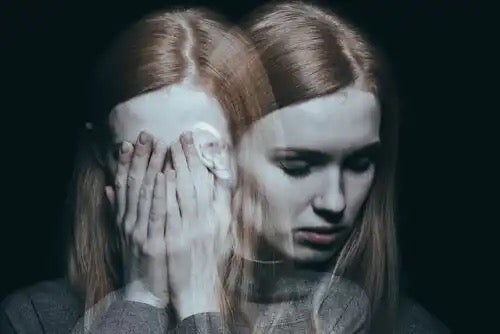Contrary to popular belief, in the context of psychotic disorders, people with schizophrenia don’t form a homogenous group. Furthermore, as a general rule, specific disorders tend to exhibit similar symptoms. However, this isn’t exactly the case with schizophrenia.
No symptom of schizophrenia is pathognomonic. In other words, no particular symptoms form the basis of this condition. For this reason, we shouldn’t actually talk about schizophrenia, but schizophrenias.
There are also other psychotic disorders. This article takes a look at some of them that tend to be overshadowed by schizophrenia.
Psychotic disorders, more than just schizophrenia
The DSM-5 classifies the schizophrenic spectrum of disorders, schizotypal personality disorder, and other psychotic disorders in the same section. They’re placed together because they’re defined by anomalies like delusions, hallucinations, disorganized thinking, extremely disorganized motor behavior, and other negative symptoms.
The following conditions are listed within the classification of psychotic disorders.
Schizoaffective disorder, a hybrid condition
Experts define schizoaffective disorder as the appearance of both a mood disorder and schizophrenia. In this condition, in addition to the presence of a mood disorder, such as depression, the sufferer will have experienced delusions or hallucinations for at least two weeks.
With this disorder, the psychotic symptoms, at some point, will have appeared without the emotional symptoms. Otherwise, it’d be classified as a mood disorder with psychotic symptoms and not a schizoaffective disorder.
Schizoaffective disorder usually occurs during an intermediate period of psychotic disorder. Schizophrenia on its own can cause a deterioration in the area of a person’s work, social, and emotional areas, hence affecting their mood. However, the emotional part of schizoaffective disorder is usually chronic and more intense.
Schizoaffective sufferers often have a stressor in their environment that motivates the onset of this condition. On the other hand, schizophrenia usually has no stressors or family history.
Delusional disorder
Delusional disorder presents one of the symptoms that can also occur in schizophrenia: delusions. A sufferer often presents an extremely persistent belief that’s contrary to reality. They don’t usually have any other schizophrenia-related symptoms.
The delusions experienced in delusional disorder aren’t usually as strange as those in schizophrenia. In fact, in this condition, the imagined events could actually occur but aren’t. However, although the delusions aren’t strange, they’re persistent and intrusive.
People with this disorder are often able to lead a fairly normal life. Depending on their delusions, they might be able to incorporate them into their daily life. In fact, in some cases, delusional disorder goes unnoticed for many years because it doesn’t affect the sufferer’s life.
Furthermore, there are no outlandish behaviors, hallucinations, emotional or language changes in this disorder, unlike schizophrenia.
There are different types of delusion in this condition. A couple of examples are the persecutory and celotypical types. For example, a man suffering these kinds of delusions might think his wife is being unfaithful, even though there are absolutely no reasons for him to believe this. Then, there’s the erotomaniacal type. These people believe that someone else, usually of higher status, is in love with them.
Brief psychotic disorder
Brief psychotic disorder is characterized by being of severe onset. Therefore, unlike in cases of schizophrenia, there’s a clear commencement date.
This disorder contains at least one of the positive symptoms of schizophrenia. These might be delusions, hallucinations, disorganized thoughts or behaviors, or catatonia. The one defining characteristic of this disorder is that it lasts less than a month and more than a day.
In addition, there’s usually a psychosocial stressor. In fact, the condition often presents itself shortly after the occurrence of the stressor. Occasionally, it happens after childbirth. In these cases, the sufferer usually returns to their pre-psychotic state after the brief psychotic disorder.
Shared psychotic disorder or folie a deux
This condition arises in a partner or family member of a sufferer of delusional disorder or schizophrenia. In fact, they assume the other’s delusional ideas.
Consequently, they also become psychotic. Similar happens in many sects. Sufferers of this disorder tend to be vulnerable, easily influenced, or isolated from society. Treatment usually involves separating the two individuals concerned.
Schizophreniform disorder
Schizophreniform disorder is often defined as mild schizophrenia. This is because its symptoms are identical. However, one of the different aspects is its duration, as it lasts less than six months. For this reason, a diagnosis of schizophrenia can’t be made. In addition, it’s usually of severe onset. Symptoms naturally disappear by the end of six months.
However, there are no established diagnostic criteria of impairment for schizophreniform disorder. In fact, people with this condition often function well, both socially and emotionally, as well as at work.

Catatonia, strange motor skills
Catatonia doesn’t appear in psychotic disorders per se, but as a syndrome due to multiple causes. It also may or may not appear in other defined psychotic disorders.
Catatonia is defined by the presence of three or more of 12 psychomotor symptoms. These symptoms can be caused by a medical or a mental condition. They can range from a complete lack of response (stupor) to severe agitation. The agitation might be simple or lead to peculiar motor behaviors such as stereotypy.
Some of these motor symptoms are stupor, catalepsy (impossibility of contracting muscles), waxy flexibility (maintenance of fixed body posture), mutism, echolalia, and echopraxia.
Schizotypal personality disorder, eccentricity
A schizotypal personality disorder isn’t a psychotic disorder but a personality disorder. However, we’re including it here because it can be confused with schizophrenia or any of the above psychotic disorders.
Personality disorders involve patterns of social and interpersonal deficiencies. This means that sufferers experience acute physical discomfort and find it difficult to relate to others. They have cognitive, perceptual, and behavioral distortions. These disorders can be similar in appearance to the first phase of schizophrenia.
Some of the distortions sufferers present are strange beliefs like clairvoyance, telepathy, sixth sense, magical thinking, and bodily illusions. Their speech will be strange, either vague and metaphorical or overly elaborate. They also exhibit paranoid ideas and eccentric behaviors.
They’re usually people with little social support. They might, on occasions, attend therapy for depression or anxiety. However, more often than not they don’t, due to the symptoms of the disorder itself. There are no hallucinations or delusions with this disorder. Nevertheless, some of the symptoms may coincide with the onset of schizophrenia.
Psychotic disorders and diagnosis
There are also some lesser-known psychotic disorders, such as Capgras syndrome or Clerembault syndrome.
Before issuing any diagnosis, a doctor must always consider, apart from schizophrenia, the possibility of this other range of major psychotic disorders. Furthermore, time, as well as the presence of negative symptoms, plays an essential role that they should never overlook.
The post Psychotic Disorders, More Than Just Schizophrenia appeared first on Exploring your mind.













Comments